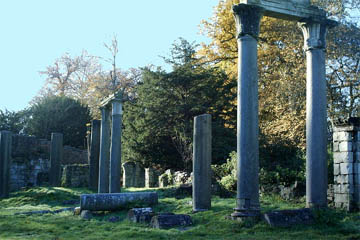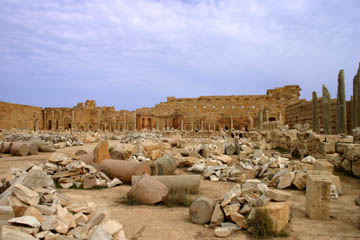Leptis Magna in Berkshire
I first visited Virginia Water in 1971 when I was a student at Newbold College in Berkshire. As a struggling student - married, to boot - we could not afford such frivilous luxuries as a car, but from time to time friends who were better off might offer to take us for a drive and a walk. Windsor Great Park was always a favourite, with Virginia Water a close second.
Only nine miles away, Virginia Water was relatively close - an important factor for impoverished students - and offered a pleasant walk around the artificial lake with the additional pleasure of feeding the ducks (or, if the wolf was particularly close to the door, of watching others feed the ducks!) One never-to-be-forgotten winter's day we arrived to find the lake frozen over and bewildered ducks staggering and slipping like drunks on its icy surface. Their antics when trying to reach the crusts tossed to them were highly diverting.

|
| The romantic ruins at Virginia Water, brought from Leptis Magna in Libya |
The walk around the lake was fairly featureless - several miles of gravelled path with the lake on one side and ornamental woods on the other - but there were three landmarks which told you where you were and how close to the car park and the ride home. The first was an artificial waterfall where a stream cascaded down artfully piled up rocks into the lake; the second was a totem pole, given by the Red Indians of Canada to the Queen in 1958, and the third was the Roman temple.
In those days the moss-covered pillars simply stood without explanation in a bay in the woods, leaving me to speculate perplexedly on the Romans in Britain. On later visits I spotted a plaque which stated that they had been brought from Leptis Magna by H.M.S. Weymouth in 1818, indicating that they were "artificial ruins" - the Romans had never erected anything at Virginia Waters, but their ruins in Libya had been plundered to provide a romantic vista in the royal park.
One wonders what the original inhabitants of Leptis would have thought, for they were the Phoenicians who, it is believed, traded with Cornwall for tin and may have ventured inland on occasion (though to be sure we have no evidence that they ever did so). Back in the seventh century BC the Phoenician settlement of LPQY rose on the north African coast some 470 miles from Carthage. Despite a common heritage, the people in LPQY were happy to switch sides and make peace with Rome during the Punic Wars.
In 109 BC Lepcis, as the Romans themselves called the place, became an associate of the Roman Province of Africa. Despite siding with Pompey and being fined by Julius Caesar in consequence, the city regained its status under Augustus and became a major Roman centre in north Africa. Indeed, it has been suggested that the Romans deliberately granted the city favours in order to keep the ruling elite "on side", for the Punic system of government remained in place well into the first century AD and official notices were carved in both Latin and Punic.
The result was a major flowering of the city based on agriculture, for the hinterland was fertile and adequately watered in those days. The major crop appears to have been olives, for around 1,500 olive presses have been found in the area around Leptis, some of them the biggest in the Roman world. A single press could produce 10,000 litres of olive oil in a good year and a major processing complex with a number of presses could export 200,000 litres a year.
Before you start wondering just what the ancient Romans did with all that virgin olive oil, the answer is, everything. It has been estimated that the average Roman citizen consumed 20 litres of oil per year, using it for cooking, lighting, and rubbing into the body. A wealthy Roman with a mansion to light might use many times that amount - and the demand for olive oil made north Africa rich.
In those days the most socially acceptable way of displaying your wealth was to engage in public building projects and we have the example of the Tabahpi family at Leptis Magna. Annobal Tapapius Rufus - known to his friends as Annobal Tabahpi - was responsible for building the market in Leptis in 8 BC (the remains of his market can be seen on Google Earth just to the east of the theatre, which he also built around AD 1 when the market was finished). Dedicatory inscriptions on both buildings dedicate them to Augustus and laud Annobal as "lover of his fellow citizens", "lover of his fatherland" and "embellisher of his fatherland".
The high point for Leptis Magna came in AD 193 when a local boy became emperor. Lucius Septimius Severus had risen to high command in the army and when Commodus was assassinated (a long-overdue reward for his depravities) and his successor Pertinax went the same way, the legions under Severus' command hailed him as emperor and marched on Rome to see that their will was carried out. In the "Year of the Five Emperors" Severus was the survivor and became the strong ruler which Rome needed.

|
| Remains of the Severan forum in Leptis Magna. |
In AD 203 he made a trip back to his birthplace and in the junketings that attended his visit he freed Leptis Magna from all taxes (which became a real burden in the rest of the empire to pay for the rise in soldiers' pay from 300 to 500 sesterces per year) and instituted a massive programme of building works. The marble forum south-east of Annobal's market, and the colonnaded street from the harbour that ran along the south wall of the forum were his work, as was the triumphal arch, a rather ugly structure with broken pediments so small as to be vestigial. (It stands south-west of Annobal's theatre.) 2,000 tons of marble were imported by ship for the arch alone.
Unfortunately not long afterwards the Roman empire went through its own version of the Wall Street Crash and this "Crisis of the Third Century" was a disaster for Leptis Magna, as demand for its produce declined precipitously. By the middle of the next century large parts of the city were uninhabited and the crisis was worsened by a greedy governor who, threatened by a Berber raid, refused to protect the city unless the citizens paid him a hefty bribe. When they were unable to meet his demands, he callously abandoned the city and let the Berbers sack it.
In AD 439 the Vandals captured the city and promptly both made it their capital in north Africa and demolished its walls, to ensure that the locals didn't rebel and use the city against them. Unfortunately the Berbers noted this and in AD 523 mounted a second raid and again sacked the city, looting both Vandals and Romans with cheerful impartiality.
In AD 533 Belisarius recaptured the city for Rome - New Rome or Byzantium - and ten years later the Roman authorities inveigled the Berber chiefs into the city and massacred them, an action which must have given the sorely tried citizens of Leptis a certain grim satisfaction. However such actions could not restore the trade on which the city depended and by the time the Arabs arrived a century later the only inhabitants of the city were its Byzantine garrison.
Today the extensive ruins are a popular destination for tourists to Libya and companies from cruise ships regularly scramble around the ruins - though if my friends, who supplied me with the photograph above, are any guide, they have no idea at all what they are seeing and might as well be looking at any other Roman ruins.
© Kendall K. Down 2009





